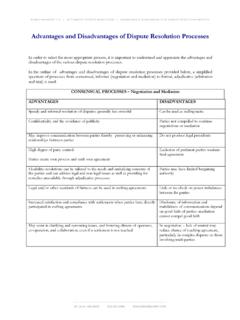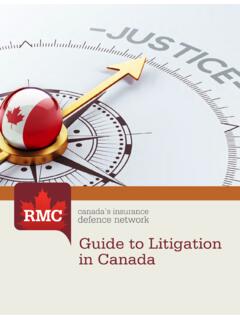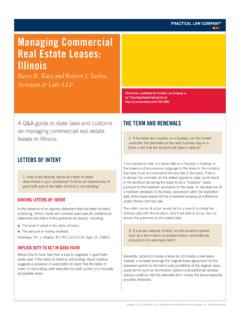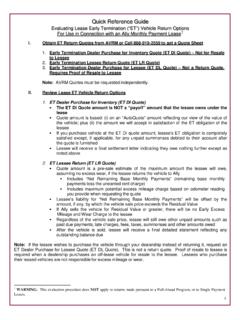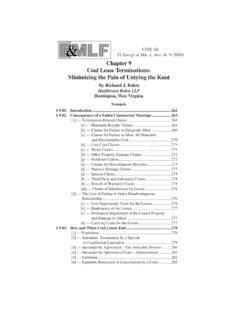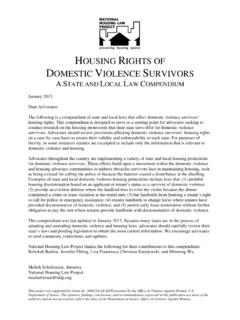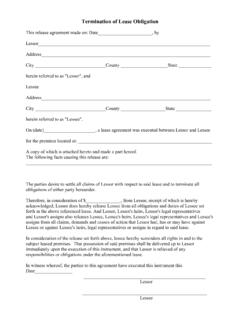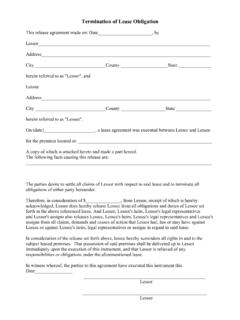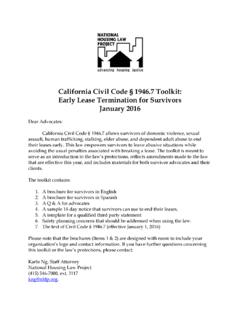Transcription of TENANT TERMINATION RIGHTS
1 Executive SummaryThe word terminate ranks first among the seven words a landlord does not want to hear on the first day of a lease negotiation. The others are abatement , set-off , allowance , reimbursement , self-help and the-landlord-shall . Accordingly, the negotiation of express RIGHTS of TERMINATION for tenants in commercial, industrial and retail leases can be a challenging paper canvasses the challenges faced by leasing lawyers when negotiating TENANT TERMINATION RIGHTS and offers strategies to overcome those challenges. In particular, it addresses (i) the types of assumptions and business terms that may need to be protected with express RIGHTS of TERMINATION , (ii) drafting techniques, and (iii) matching issues with appropriate remedies.
2 This paper also reviews the circumstances in which a TENANT s common law RIGHTS may be relied upon as a basis for terminating a lease and considers the risks associated with doing so. Many of the issues addressed in this paper are examined from a retail perspective in Ontario, Canada and many of the cases are taken from across Canada. This paper is directed to lawyers and people engaged in drafting offers to lease and leases in challenge faced by lawyers when negotiating a lease document is putting a real estate deal, and the parties expectations and assumptions, into words. In a recent lease negotiation involving premises located at a major regional shopping centre, we noted that the landlord s retail lease precedent contained more than 47,000 words and numerous pages of diagrams, pictures and other images.
3 Upon completion of the lease , we ran the document through a word cloud generator to obtain a visual depiction of the prominence of the words found in the TENANT TERMINATION RIGHTSA uthored by Dennis Tobin and Michael GilburtiAs one would expect, the most prominent words in the word cloud were TENANT , Landlord , lease , Project and Premises. This paper is about the word TERMINATION . If the word cloud was the Milky Way Galaxy, the word TERMINATION would be the Earth; a mere blip in a constellation of language dominated by covenants, restrictions and conditions. The following are some simple statistics derived from our sample lease that illustrate the rarity of TERMINATION RIGHTS .
4 In the lease document there were a total of 30 occurrences of the word terminate . Of those 30 occurrences, 18 were in respect of mutual RIGHTS of TERMINATION ( holding over, damage and destruction, expropriation) and 6 were in respect of the landlord s right to terminate ( right to recapture on TENANT going dark, improper or prohibited transfers or assignments, environmental breaches, constructions breaches and Events of Default).That leaves 6 references involving the unilateral right of the TENANT to terminate, which relate to three circumstances: delay of possession, co-tenancy and a negotiated one-time right to terminate after a given period of in this lease the TENANT was a major TENANT with a lot of negotiating strength.
5 It is very common for tenants to have no unilateral RIGHTS to terminate, few mutual RIGHTS to terminate and very little leverage to delete the landlord s RIGHTS of TERMINATION . This is true because: (i) landlords typically hold the upper hand when a TENANT is negotiating a lease for coveted space; and (ii) the inclusion of a unilateral TERMINATION right in favour of the TENANT has definite financial consequences to the landlord when it finances or sells its property. TERMINATION RIGHTS are rare for a In Drafting TERMINATION RIGHTS for TenantsExperience has taught us the following lessons when negotiating and drafting TERMINATION RIGHTS :(a) Terminate is one of the seven words a landlord does not want to hear on the first day of a lease negotiation.
6 The others are abatement , set-off , allowance , reimbursement , self-help and the-landlord-shall . In all likelihood, to get any of these words into the lease you should have negotiated it into the offer to lease in the first place. Thereafter, to improve the prominence of one of those words you are going to give up the prominence of another. (b) Well drafted TERMINATION clauses are more likely to result in the avoidance of conflict and lead to negotiated resolutions. If the clause is well drafted and easy to understand, the parties are less likely to test it and it will include negotiated limits and pre-conditions on the right to terminate. (c) Poorly drafted TERMINATION clauses lead to conflict.
7 Parties get their hopes up in the event they can put a self-serving spin on the language. Also, if particular circumstances are not anticipated and addressed in the drafting, uncertainty will work against the party seeking to rely on the TERMINATION right. (d) Resort to the Courts is an uncertain process and can result in unintended consequences and a great deal of expense. However, the finality of TERMINATION RIGHTS often leads parties to believe that they have no alternative but to seek Court intervention in order to obtain relief ( relief from forfeiture or a favourable Court interpretation) or to delay the inevitable exercise of the TERMINATION right. Landlords will often attempt to use the Court process as a means of deterring the exercise of TERMINATION RIGHTS by requiring that TERMINATION be contingent on a judicial predetermination that the landlord is in fact in breach.
8 What to Keep in MindExpress written remedies such as a right to terminate are usually the final consideration in the TENANT s evaluation of the opportunity and the negotiation of the lease deal. Often, the issue of remedies is dealt with far too late in the negotiation and, if such remedies are negotiated, the parties do not come away from the negotiation with a sufficient understanding of which remedies are available in which circumstances. Further, in a graduated series of counter-proposals offered by the landlord in response to a TENANT s proposed TERMINATION right, what is ultimately agreed upon may seem like a reasonable compromise, but in practical terms provides very little protection to the TENANT .
9 In order to avoid the foregoing issues and ensure the TERMINATION RIGHTS you negotiate into the lease are clear and responsive to the TENANT s concerns, consider adopting the following approaches:i. Identify AssumptionsWhen prospective tenants draft a pro-forma business case for a lease deal, they should identify their assumptions. Next, the TENANT and its advisers should ask themselves: what is the appropriate remedy if those assumptions are not correct? For example, a landlord may propose that a TENANT pay a fixed rate of $X per year in net rent for the premises rather than a rate per square foot. The TENANT agrees to this proposal based on the assumption that the estimated area of the premises set out in the offer to lease is correct.
10 But what if the offer states that the premise is approximately 8,000 square feet and the TENANT later discovers that it is only 6,500? If the premises are unsuitable as a result, is a reduction in rent sufficient? Or, as another example, consider a situation where the landlord commits to deliver the premises with all of the landlord s work completed by the possession date. What if it does not? What if the TENANT has to leave its current premises and needs continuity for its office, warehouse or retail use? What if force majeure intervenes and the possession date becomes uncertain or delayed for a significant period of time? Does the TENANT want to wait or could it (must it) find another location?

